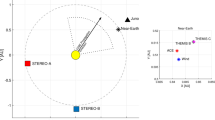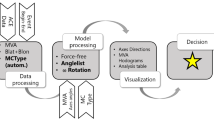Abstract
We report, in detail, an optimization approach for fitting a three-dimensional (3D) magnetic cloud (MC) model to in situ spacecraft measurements. The model, dubbed the Freidberg solution, encompasses 3D spatial variations in a generally cylindrical geometry, as derived from a linear force-free formulation. The approach involves a least-squares minimization implementation with uncertainty estimates from magnetic field measurements. We present one case study of the MC event on 22 May 2007 to illustrate the method and demonstrate the satisfying result of the minimum reduced \(\chi^{2}\lesssim1\), obtained from the Solar and TErrestrial RElations Observatory (STEREO) Behind spacecraft measurements. In addition, since the Advanced Composition Explorer (ACE) spacecraft at Earth crossed the STEREO Behind solution domain with an appropriate separation distance, the result from the optimally fitted Freidberg solution along the ACE spacecraft path is compared with the actual measurements of magnetic field components. A correlation coefficient of 0.89 is obtained between the two sets of data.








Similar content being viewed by others
References
Burlaga, L.F.: 1988, Magnetic clouds and force-free fields with constant alpha. J. Geophys. Res. 93(A7), 7217. DOI.
Burlaga, L.F.: 1995, Interplanetary magnetohydrodynamics. In: Burlag, L.F., Interplanetary Magnetohydrodynamics, Int. Ser. Astron. Astrophys. 3, 272, Oxford University Press, London. ISBN13: 978-0-19-508472-6. ADS.
Chollet, E.E., Mewaldt, R.A., Cummings, A.C., Gosling, J.T., Haggerty, D.K., Hu, Q., Larson, D., Lavraud, B., Leske, R.A., Opitz, A., Roelof, E.C., Russell, C.T., Sauvaud, J.-A.: 2010, Multipoint connectivity analysis of the May 2007 solar energetic particle events. J. Geophys. Res. 115(A12), A12106. DOI.
Dasso, S., Mandrini, C.H., DéMoulin, P., Farrugia, C.J.: 2003, Magnetic helicity analysis of an interplanetary twisted flux tube. J. Geophys. Res. 108(A10), 1362. DOI. ADS.
Farrugia, C.J., Janoo, L.A., Torbert, R.B., Quinn, J.M., Ogilvie, K.W., Lepping, R.P., Fitzenreiter, R.J., Steinberg, J.T., Lazarus, A.J., Lin, R.P., Larson, D., Dasso, S., Gratton, F.T., Lin, Y., Berdichevsky, D.: 1999, A uniform-twist magnetic flux rope in the solar wind. In: Suess, S.T., Gary, G.A., Nerney, S.F. (eds.) Amer. Inst. Phys. Conf. Ser. 471, 745. DOI. ADS.
Freidberg, J.P.: 2014, Ideal MHD, Cambridge University Press, Cambridge, 546.
Hidalgo, M.A., Nieves-Chinchilla, T.: 2012, A global magnetic topology model for magnetic clouds. I. Astrophys. J. 748(2), 109. DOI. ADS.
Hidalgo, M.A., Cid, C., Vinas, A.F., Sequeiros, J.: 2002, A non-force-free approach to the topology of magnetic clouds in the solar wind. J. Geophys. Res. 107(A1), 1002. DOI. ADS.
Hu, Q.: 2017a, The Grad–Shafranov reconstruction in twenty years: 1996 – 2016. Sci. China Earth Sci. 60, 1466. DOI. ADS
Hu, Q.: 2017b, The Grad–Shafranov reconstruction of toroidal magnetic flux ropes: method development and benchmark studies. Solar Phys. 292, 116. DOI. ADS.
Hu, Q., Linton, M.G., Wood, B.E., Riley, P., Nieves-Chinchilla, T.: 2017, The Grad–Shafranov reconstruction of toroidal magnetic flux ropes: first applications. Solar Phys. 292(11), 171. DOI. ADS.
Hu, Q., He, W., Qiu, J., Vourlidas, A., Zhu, C.: 2021, On the quasi-three dimensional configuration of magnetic clouds. Geophys. Res. Lett. 48(2), e2020GL090630. DOI.
Khrabrov, A.V., Sonnerup, B.U.Ö.: 1998, DeHoffmann–Teller analysis. ISSI Sci. Rep. Ser. 1, 221. ADS.
Kilpua, E.K.J., Liewer, P.C., Farrugia, C., Luhmann, J.G., Möstl, C., Li, Y., Liu, Y., Lynch, B.J., Russell, C.T., Vourlidas, A., Acuna, M.H., Galvin, A.B., Larson, D., Sauvaud, J.A.: 2009, Multispacecraft observations of magnetic clouds and their solar origins between 19 and 23 May 2007. Solar Phys. 254, 325. DOI. ADS.
Lepping, R.P., Burlaga, L.F., Jones, J.A.: 1990, Magnetic field structure of interplanetary magnetic clouds at 1 AU. J. Geophys. Res. 95, 11957. DOI. ADS.
Lepping, R.P., Burlaga, L.F., Szabo, A., Ogilvie, K.W., Mish, W.H., Vassiliadis, D., Lazarus, A.J., Steinberg, J.T., Farrugia, C.J., Janoo, L., Mariani, F.: 1997, The wind magnetic cloud and events of October 18-20, 1995: interplanetary properties and as triggers for geomagnetic activity. J. Geophys. Res. 102, 14049. DOI. ADS.
Liu, Y., Luhmann, J.G., Huttunen, K.E.J., Lin, R.P., Bale, S.D., Russell, C.T., Galvin, A.B.: 2008, Reconstruction of the 2007 May 22 magnetic cloud: how much can we trust the flux-rope geometry of CMEs? Astrophys. J. Lett. 677, L133. DOI. ADS.
Lundquist, S.: 1950, On force-free solution. Ark. Fys. 2, 361.
Möstl, C., Miklenic, C., Farrugia, C.J., Temmer, M., Veronig, A., Galvin, A.B., Vršnak, B., Biernat, H.K.: 2008, Two-spacecraft reconstruction of a magnetic cloud and comparison to its solar source. Ann. Geophys. 26, 3139. DOI. ADS.
Möstl, C., Farrugia, C.J., Miklenic, C., Temmer, M., Galvin, A.B., Luhmann, J.G., Kilpua, E.K.J., Leitner, M., Nieves-Chinchilla, T., Veronig, A., Biernat, H.K.: 2009a, Multispacecraft recovery of a magnetic cloud and its origin from magnetic reconnection on the Sun. J. Geophys. Res. 114, A04102. DOI. ADS.
Möstl, C., Farrugia, C.J., Biernat, H.K., Leitner, M., Kilpua, E.K.J., Galvin, A.B., Luhmann, J.G.: 2009b, Optimized Grad – Shafranov reconstruction of a magnetic cloud using STEREO- wind observations. Solar Phys. 256, 427. DOI. ADS.
Nieves-Chinchilla, T., Linton, M.G., Hidalgo, M.A., Vourlidas, A., Savani, N.P., Szabo, A., Farrugia, C., Yu, W.: 2016, A circular-cylindrical flux-rope analytical model for magnetic clouds. Astrophys. J. 823, 27. DOI. ADS.
Press, W.H., Teukolsky, S.A., Vetterling, W.T., Flannery, B.P.: 2007, Numerical Recipes in C++ : The Art of Scientific Computing, 778, Cambridge University Press, New York. http://numerical.recipes/. ADS.
Vandas, M., Romashets, E.P.: 2003, A force-free field with constant alpha in an oblate cylinder: a generalization of the Lundquist solution. Astron. Astrophys. 398, 801. DOI. ADS.
Vandas, M., Romashets, E.: 2017, Toroidal flux ropes with elliptical cross sections and their magnetic helicity. Solar Phys. 292(9), 129. DOI. ADS.
Acknowledgements
QH acknowledges NASA grants 80NSSC17K0016, 80NSSC18K0622, 80NSSC19K0276, 80NSSC21K0003, and NSF grants AGS-1650854, and AGS-1954503 for support. The ACE spacecraft Level2 data are accessed via the ACE Science Center (http://www.srl.caltech.edu/ACE/ASC/). The STEREO spacecraft data are accessed via the STEREO Science Center (https://stereo-ssc.nascom.nasa.gov/) and NASA CDAWeb (https://cdaweb.gsfc.nasa.gov/index.html/).
Author information
Authors and Affiliations
Corresponding author
Ethics declarations
Disclosure of Potential Conflicts of Interest
The author declares that there are no conflicts of interest.
Additional information
Publisher’s Note
Springer Nature remains neutral with regard to jurisdictional claims in published maps and institutional affiliations.
Appendix: The DeHoffmann–Teller (HT) Analysis
Appendix: The DeHoffmann–Teller (HT) Analysis
The DeHoffmann–Teller (HT) analysis is used to determine an HT frame from the time-series data, following the approach given by Khrabrov and Sonnerup (1998). One advantage of an HT frame is that by definition, in the HT frame, the electric field vanishes, then it follows from the Faraday law, the time-dependence of the magnetic induction \(\mathbf{B}\) should also vanish. Therefore the magnetic field can be regarded to be stationary in time, consistent with the MC model assumptions.
Namely, for a time-series interval containing magnetic field \(\mathbf{B}^{(m)}\) and plasma bulk flow velocity \(\mathbf{V}^{(m)}\) measurements (\(m=1,2, \ldots, M\)) in the spacecraft frame, a constant HT frame velocity \(\mathbf{V}_{HT}\) is obtained by minimizing (Khrabrov and Sonnerup, 1998):
The quality of an HT frame is demonstrated by the component-wise plots of \(\mathbf{E}_{c}=\mathbf{V}\times\mathbf{B}\) versus \(\mathbf{E}_{HT}=\mathbf{V}_{HT}\times\mathbf{B}\), and \(\mathbf{v'}=\mathbf{V}-\mathbf{V}_{HT}\) versus the Alfvén velocity \(\mathbf{V}_{A}\). The latter (so-called Walén plot) also indicates the relative importance of the inertia force (i.e. \(\rho\mathbf{v'}\cdot\nabla\mathbf{v'}\)) compared to the Lorentz force in the HT frame. Two metrics, the correlation coefficient for the former, and the slope of a linear regression line for the latter, are calculated, respectively.
For the STB MC interval given in Figure 2, Figure 9 shows the HT analysis results with the HT frame velocity \(\mathbf{V}_{HT}=[ 440.16, -36.54, -0.08099]\) km/s in RTN coordinates. The corresponding correlation coefficient and regression line slope are 0.9990 and −0.084, respectively. For the STA MC interval marked in Figure 6 (right), the corresponding correlation coefficient and regression line slope are 0.9978 and 0.033, respectively, with \(\mathbf{V}_{HT}= [482.66, 38,47, -16.28]\) km/s in RTN coordinates. Therefore for both cases, the assumption of time-stationary quasi-static equilibrium is satisfied when the analysis was carried out in the corresponding HT frame (with the correlation coefficient \(\approx1.0\) and the magnitude of Walén slope \(\ll1.0\)).
Rights and permissions
About this article
Cite this article
Hu, Q. Optimal Fitting of the Freidberg Solution to In Situ Spacecraft Measurements of Magnetic Clouds. Sol Phys 296, 101 (2021). https://doi.org/10.1007/s11207-021-01843-z
Received:
Accepted:
Published:
DOI: https://doi.org/10.1007/s11207-021-01843-z





